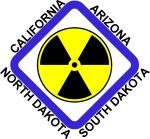*PL 99-240 Definition of Low-Level Radioactive Waste as amended by Energy Policy Act of 2005 (P.L. 109-59)
(9) Low-level radioactive waste
(A) IN GENERAL – The term “low-level radioactive waste” means radioactive material that—
(i) is not high-level radioactive waste, spent nuclear fuel, or byproduct material (as defined in section 2014(e)(2) of this title); and
(ii) the Nuclear Regulatory Commission, consistent with existing law and in accordance with paragraph (A), classifies as low-level radioactive waste.
(B) EXCLUSION – The term “low-level radioactive waste” does not include byproduct material (as defined in paragraphs (3) and (4) of section 2014(e) of this Title).
Please note byproduct material as defined in 2014(e)(2), 2014(e)(3) and 2014(e)(4) is expressly excluded by law from the definition of LLRW.
For ease of reference the definition in 42 U.S.C. 2014(e) follows:
“(e) The term “byproduct material” means —
(1) any radioactive material (except special nuclear material) yielded in or made radioactive by exposure to the radiation incident to the process of producing or utilizing special nuclear material;
(2) the tailings or wastes produced by the extraction or concentration of uranium or thorium from any ore processed primarily for its source material content;
3(A) any discrete source of radium-226 that is produced, extracted, or converted after extraction, before, on, or after August 8, 2005, for use for a commercial, medical, or research activity; or
(B) any material that–
(i) has been made radioactive by use of a particle accelerator; and
(ii) is produced extracted, or converted after extraction, before, on, or after August 8, 2005, for use for a commercial, medical, or research activity; and
(4) Any discrete source of naturally occurring radioactive material, other than source material, that —
(A) the Commission, in consultation with the Administrator of the Environmental Protection Agency, the Secretary of Energy, the Secretary of Homeland Security, and the head of any other appropriate Federal agency, determines would pose a threat similar to the threat posed by a discrete source of radium -226 to the public health and safety or the common defense and security; and
(B) before, on, or after August 8, 2005, is extracted or converted after extraction for use in a commercial, medical, or research activity.”]
